Magnetometers
One of the instruments that Bob and Andy keep running at the AGOs is a magnetometer. A magnetometer measures the strength and changes of the magnetic field. The magnetic field interacts with weather from outer space, so by studying the magnetic field, one can better understand how weather from outer space interacts with the Earth.
Fluxgate and Search Coil
The AGO team uses both fluxgate and search coil magnetometers to measure the magnetic field. I will be explaining these instruments and the work we do at the AGO in more depth once we are out there. Yesterday I met Hyomin Kim, a post-doctoral student who is working on another project that is also using a search coil magnetometer. Although our projects are different, we are part of the same, larger network of groups that are studying space weather.
Frequency is lower, period is longer with search coil -- long period low frequency phenomeno
A search A fluxgate magnetometer measures the magnetic field at a lower frequency, which means it is less sensitive to changes in the magnetic field than a search coil magnetometer. Search coil magnetometers measure the magnetic field at a more sensitive frequency.
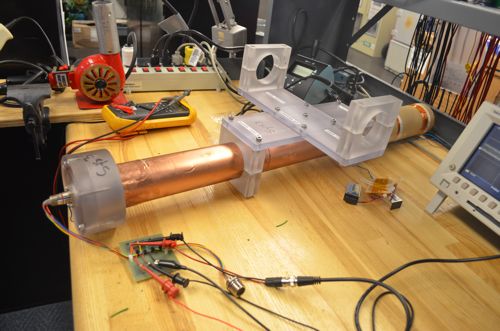
How they work
Search coil magnetometers work by using Faraday's Law, which is the principle that if you pass a magnet through a coil of wire, you create an electric current. Search coil magnetometers contain wire that is wrapped around a tube. There is also metal in the tube called permalloy, which has a higher magnetism than other substances, allowing the electric current to be stronger if a magnetic field moves through it. When the magnetic field changes it moves, and this creates a different electric current in the wires of the search coil magnetometer.
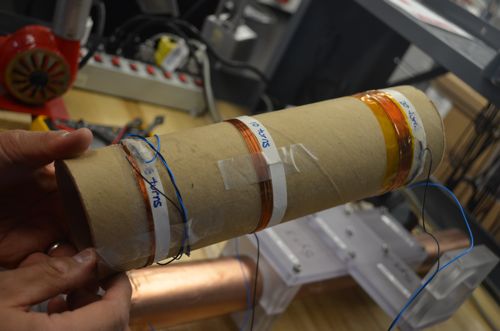
The current can be recorded and the data can be used as a record of changes in the magnetic field.
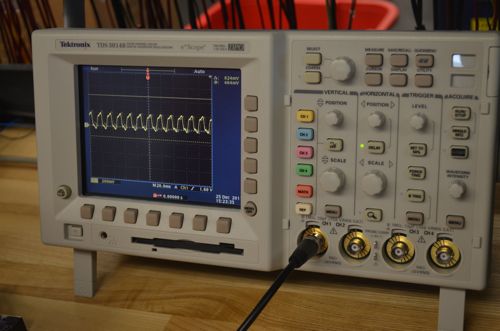
The search coil magnetometer only records changes that are perpendicular to the tube. For that reason, two magnetometers are used and placed at different angles. Hyomin displayed the sensitivity of the magnetometer to me by moving a slightly magnetic tool near the instrument.
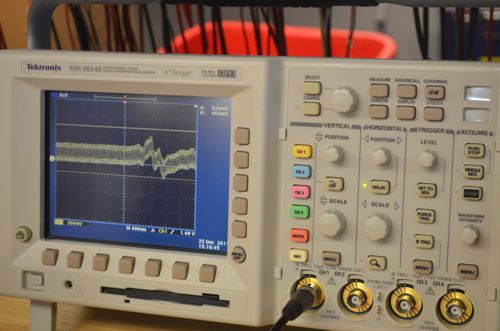
What causes the magnetometer to change its current?
The short coil magnetometer can be influenced by a number of phenomena. Here are the main causes that Hyomin discussed with me:
Earthquakes: The earth is composed of magnetic substances (i.e., iron). When earthquakes occur, they move these magnetic rocks, creating a change in the magnetic field. This can be recorded in the magnetometer.
Man-made: Although humans do not often influence the magnetometer at the South Pole, the electronic networks that humans create can affect a magnetometer. One of the reasons Hyomin's group and the AGO group study space weather at the South Pole is to avoid these influences.
Space weather (solar wind): Solar wind is full of charged particles. They affect the magnetic field and when there is a large burst of them, they can create a storm in the magnetic field, dramatically changing it. Solar wind and space weather is a major influence on the fluxgate and search coil magnetometers. This is why Hyomin's group and our group are using them to understand space weather.
Local disturbances: If the search coil magnetometer is moved or shaken, it will record a change in the current it records. Wind or stormy weather could, therefore, affect the instrument. Although Hyomin's group tries to account for this and secures the magnetometer as best they can, they are aware that the data they receive could sometimes be due to local weather or disturbances.
AALPIP
Hyomin's project is called AALPIP, which stands for: Autonomous Adaptive Low Pressure Instrument Platform. His group is doing similar work to our AGO group. They place a fluxgate magnetometer and two search coil magnetometers at specific sites, based on the magnetic field. They also have a GPSA Global Positioning System (GPS) is a satellite-based navigation system used to track the location or position of objects on the Earth’s surface. system, however this is not like the GPSA Global Positioning System (GPS) is a satellite-based navigation system used to track the location or position of objects on the Earth’s surface. system people use to find their way places. This GPSA Global Positioning System (GPS) is a satellite-based navigation system used to track the location or position of objects on the Earth’s surface. system compares the frequencies of the satellites signals it receives. By comparing the differences in the frequencies of the signals, it can calculate how many electrons are in the ionosphere. This is known as the Total Electron Content (TEC). By using the TEC, scientists can map out the ionosphere and identify any irregularities in it. The ionosphere is the part of the atmosphere that has charged particles (ions) due to radiation from the sun. The reason Hyomin's group is interested in TEC is because it can affect the magnetic field.
Out in the field
Hyomin's group currently has their instruments near the South Pole Station to test them. They also have one set of instruments at a place called PG-2, which is about 300 miles away. If their instruments seem to be working correctly, they will start moving them to field sites next year. You can learn more about his work here
Cool Careers in Antarctica
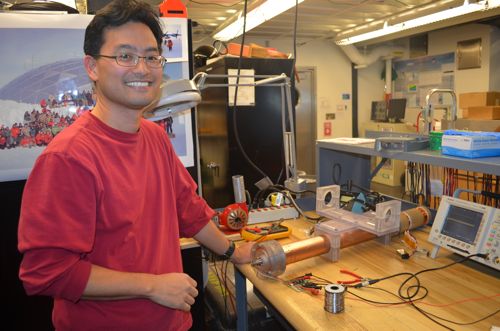
Meet Hyomin Kim. Hyomin is a post-doctoral students at the Center for Space Science and Engineering Research at Virgina Tech. Hyomin is from Seoul, Korea. As a child he was always interested in outer space. Unlike other scientists I have spoken with, he did not follow the path of his parents. His father was an English teacher, and his mother raised him and his siblings. He followed his love of space science and studied it as an undergraduate student in Korea. His advisor introduced him to well-known scientists in the field, which allowed him to continue his studies as a master's and graduated student in the U.S. This is his fifth season in Antarctica, and his fourth time at the South Pole. His most memorable experience in Antarctica was last year, when he went out to the remote PG-2 site and camped. He was struck by the emptiness around him and the experience of camping in tents out on the ice shelf. He is also appreciative for other experiences here. He says: "Anything you do here is memorable."
Questions
How is a fluxgate magnetometer similar to a search coil magnetometer? How is it different?
Why does Hyomin's group prefer to have two search coil magnetometers at each site?
Why would Hyomin's group want to keep their instruments close to the South Pole Station before moving them to remote field sites?
Math Connection
If Hyomin's team has three sites, how many total search coil magnetometers will they need? How many total instruments will they have at each site?

Comments